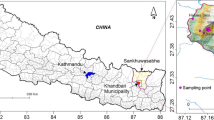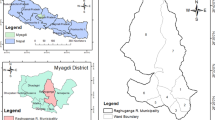Abstract
Spring water is a reliable source of potable water to many communities and habitants in western Himalayan region of India. The present study evaluates the hydrochemical nature of spring water using various drinking parameters and agricultural indices in upper Beas basin of Kullu Valley, Himachal Pradesh, India. Fifty springs were sampled for the estimation of physico-chemical parameters and major ions. The results indicate that majority of the spring waters in the study area are suitable for drinking as well as irrigation purposes except for few locations. About 14% of springs showed high nitrate content (45 to 92.6 mg/L) more than BIS permissible limit of 45 mg/L. The source of contamination could be sewage disposal, livestock waste and fertilizers. Fluoride (0.16–0.49 mg/L) was found to be within permissible limits for drinking. Drinking Water Quality Index ranges from 1.74 to 108, and Irrigation Water Quality Index ranges from 0.27 to 8.21. Both these indices indicate that the spring water falls in excellent to good category and is suitable in terms of potability and irrigation uses. Hydrogeochemical characteristics of the spring waters indicate that alkaline earths (Ca2+ + Mg2+) dominate alkalies (Na+ + K+) and strong acids (SO42− + Cl−) dominate weak acids (CO32− + HCO3−). Based on Piper’s classification, the spring water data falls in no cation–no anion dominant zone followed by carbonate hardness (secondary alkalinity) zone and hydrochemical trends (Piper’s and Gibb’s plots) inferred that spring water chemistry is mainly controlled by water rock interaction followed by rainwater chemistry.






Similar content being viewed by others
References
Niti Aayog (2018) Report of working group 1 inventory and revival of springs in the Himalayas for water security. https://niti.gov.in/writereaddata/files/document_publication/doc1.pdf
Ako AA, Shimada J, Hosono T, Kagabu M, Ayuk AR, Nkeng GE, Eyong GET, Fouepe Takounjou AL (2012) Spring water quality and usability in the Mount Cameroon area revealed by hydrogeochemistry. Environ Geochem Health 34(5):615–639. https://doi.org/10.1007/s10653-012-9453-3
Al-Khashman OA (2008) Assessment of the spring water quality in the Shoubak area, Jordan. Environmentalist 28:203–215. https://doi.org/10.1007/s10669-007-9129-1
APHA (2005) Standard methods for the examination of water and wastewater, 21st edn. DC. American Public Health Association, Washington
Appelo CAJ, Postma D (2005) Geochemistry, groundwater and pollution. CRC Press
Ayra RG (1997) Water resources of India. CWC Publication, New Delhi
BIS (Bureau of Indian Standards) (2012) Indian standards specification for drinking water. 2nd edn. IS 10500. BIS. New Delhi
Brindha K, Kavitha R (2014) Hydrochemical assessment of surface water and groundwater quality along Uyyakondan channel, South India. Environ Earth Sci 73:5383–5393. https://doi.org/10.1007/s12665-014-3793-5
Brindha K, Vaman KN, Srinivasan K et al (2014) Identification of surface water-groundwater interaction by hydrogeochemical indicators and assessing its suitability for drinking and irrigational purposes in Chennai, Southern India. App Water Sci 4:159–174. https://doi.org/10.1007/s13201-013-0138-6
Brown RM, McClelland NI, Deininger RA, Tozer RG (1970) Water quality index- do we dare. Water Sewage Works 117:339–343
CGWB (2013) Groundwater information booklet Kullu district, Himachal Pradesh. Ministry of Water Resources, Government of India http://cgwb.gov.in/District_Profile/HP/Kullu.pdf .
Chapagain PS, Ghimire M, Shrestha S (2019) Status of natural springs in the Melamchi region of the Nepal Himalayas in the context of climate change. Environ Dev and Sustain 21:263–280
Chidambaram S, Prasanna MV, Singaraja C, Thilagavathi R, Pethaperumal S, Tirumalesh K (2012) Study on the saturation index of the carbonates in the groundwater using WATEQ4F in layered coastal aquifers of Pondicherry. J Geol Soc India 80:813–824. https://doi.org/10.1007/s12594-012-0210-0
Durfor CN, Becker EDITH (1964) Geological Survey Water Supply Paper 1812. Washington, US Government Printing Office 1–364
Gibbs RJ (1970) Mechanism controlling world water chemistry. Sciences 170:795–840
GSI (2017) Geological Survey of India. https://www.gsi.gov.in/webcenter/portal.
Heinz B, Birk S, Liedl R, Geyer T, Straub KL, Andresen J, Bester K, Kappler A (2009) Water quality deterioration at a karst spring (Gallusquelle, Germany) due to combined sewer overflow: evidence of bacterial and micro-pollutant contamination. Environ Geol 57:797–808. https://doi.org/10.1007/s00254-008-1359-0
Hem JD (1985) Study and interpretation of the chemical characteristics of natural water (volume 2254). USGS, Water Supply Paper
Horton RK (1965) An index-number system for rating water quality. J Water Pollut Control Fed 37:300–305
Hounslow A (1995) Water quality data: analysis and interpretation. CRC press, Boca Raton, FL
Infusino E, Callegari G, Cantasano N (2016) Release of nutrients into a forested catchment of southern Italy. Rend Fis Acc Lincei 27:127–134. https://doi.org/10.1007/s12210-015-0480-8
IPH (2017) Irrigation and Public Health Department, Division No. 1 Kullu, District Kullu, Himachal Pradesh, India. http://hpiph.org/ach/kul.htm
Keesari T, Ramakumar KL, Chidambaram S, Pethperumal S, Thilagavathi R (2016) Understanding the hydrochemical behavior of groundwater and its suitability for drinking and agricultural purposes in Pondicherry area, South India–a step towards sustainable development. Groundwater Sust Dev 2:143–153. https://doi.org/10.1016/j.gsd.2016.08.001
Kirch A (2002) Impact of tourism and urbanization on water supply and water quality in Manali, northern India. Canadian Water Res J 27:383–400. https://doi.org/10.4296/cwrj2704383
Kresic N, Stevanovic Z (2010) Groundwater hydrology of springs: engineering, theory. Management and Sustainability, Butterworth-Heinemann, Amsterdam, Boston
Li P, Wu J, Qian H (2016) Hydrochemical appraisal of groundwater quality for drinking and irrigation purposes and the major influencing factors: a case study in and around Hua County, China. Arab J Geosci 9:15. https://doi.org/10.1007/s12517-015-2059-1
Marini L, Ottonello G, Canepa M, Cipolli F (2000) Water-rock interaction in the Bisagno Valley (Genoa, Italy): application of an inverse approach to model spring water chemistry. Geochim Cosmochim Acta 64:2617–2635. https://doi.org/10.1016/S0016-7037(00)00383-5
Michalczyk Z, Chmiel S, Głowacki S, Sposób J, Zielińska B (2020) Discharge of the springs of the Lublin Upland and Roztocze. Ecohyd Hyd. https://doi.org/10.1016/j.ecohyd.2020.07.003
Nair HC, Padmalal D, Joseph A (2015) Hydrochemical assessment of tropical springs—a case study from SW India. Environ Monit Assess 187:48. https://doi.org/10.1007/s10661-014-4164-0
Pant CC, Rawat PK (2015) Declining changes in spring hydrology of non-glacial river basins in Himalaya: a case study of Dabka catchment. In: Dynamics of climate change and water resources of northwestern Himalaya. Society of Earth Scientists Series. Springer, Cham, pp 151–179. https://doi.org/10.1007/978-3-319-13743-8_13
Paul R, Brindha K, Gowrisankar G, Tan ML, Singh MK (2019) Identification of hydrogeochemical processes controlling groundwater quality in Tripura, Northeast India using evaluation indices, GIS, and multivariate statistical methods. Environ Earth Sci 78:470. https://doi.org/10.1007/s12665-019-8479-6
Piper AM (1944) A graphic procedure in the geochemical interpretation of water-analyses. EOS Trans Am Geophys Union 25:914–928. https://doi.org/10.1029/TR025i006p00914
Prasanna MV, Chidambaram S, Kumar GS, Ramanathan AL, Nainwal HC (2011) Hydrogeochemical assessment of groundwater in Neyveli Basin, Cuddalore District, South India. Arab J Geosci 4:319–330. https://doi.org/10.1007/s12517-010-0191-5
Rademacher LK, Clark JF, Hudson GB, Erman DC, Erman NA (2001) Chemical evolution of shallow groundwater as recorded by springs, Sagehen basin; Nevada County, California. Chem Geol 179:37–51. https://doi.org/10.1016/S0009-2541(01)00314-X
Ramesh S, Sukumaran N, Murugesan AG, Rajan MP (2010) An innovative approach of drinking water quality index—a case study from southern Tamil Nadu, India. Ecol Indic10:857–868. https://doi.org/10.1016/j.ecolind.2010.01.007
Rani S, Sreekesh S (2019) Evaluating the responses of stream flow under future climate change scenarios in a Western Indian Himalaya watershed. Environ Proc 6:155–174
Reddy DV, Nagabhushanam P, Peters E (2011) Village environs as source of nitrate contamination in groundwater: a case study in basaltic geo-environment in central India. Environ Monit Assess 174:481–492
Sawyer CN, McCarty PL (1978) Chemistry of environmental engineering. McGraw-Hill, New York
Singh G, Rishi MS, Herojeet R, Kaur L, Sharma K (2020) Multivariate analysis and geochemical signatures of groundwater in the agricultural dominated taluks of Jalandhar district, Punjab, India. J Geochem Exp 208:106395. https://doi.org/10.1016/j.gexplo.2019.106395
SLUSI (2013) Soil resource mapping district Kullu and Mandi, Himachal Pradesh. Soil and Land Use of Survey India
Szabolcs I, Darab C (1964) The influence of irrigation water of high sodium carbonate content of soils. Proceedings of 8th international congress of ISSS trans 2:803-812
Tambe S, Dhakal S et al (2020) Scaling up spring revival in the Himalaya: graduating from spring-centric to aquifer-centric nature-based solutions. NbS Resil Ecosys and Soci 29-50. https://doi.org/10.1007/978-981-15-4712-6
Thakur N (2019) Vulnerability assessment of the status of Himalayan springs in the headwaters of Beas basin in Kullu Valley, Himachal Pradesh, India. Ph.D. Thesis. Panjab University, Chandigarh
Thakur N, Rishi M, Sharma DA, Keesari T (2018a) Quality of water resources in Kullu Valley in Himachal Himalayas, India: perspective and prognosis. App water Sci 8:20. https://doi.org/10.1007/s13201-018-0668-z
Thakur N, Rishi M, Keesari T, Sharma DA (2018b) Assessment of changes in land use and land cover patterns using RS and GIS: a case study of Upper Beas Basin of Kullu Valley in Western Himalayas, India. AISECT Uni J Vol. VII/Issue XIV
Thakur N, Rishi M, Keesari T, Sharma DA, Sinha UK (2019) Assessment of recharge source to springs in upper Beas basin of Kullu region, Himachal Pradesh, India using isotopic signatures. J Radioanal Nucl Chem 323:1217–1225. https://doi.org/10.1007/s10967-019-06617-3
Vasanthavigar M, Srinivasamoorthy K, Vijayaragavan K, Rajiv Ganthi R, Chidambaram S, Anandhan P, Manivannan R, Vasudevan S (2010) Application of water quality index for groundwater quality assessment: Thirumanimuttar sub-basin, Tamilnadu, India. Environ Monit Assess 171:595–609. https://doi.org/10.1007/s10661-009-1302-1
Vesper DJ, Herman EK (2020) Common spring types in the valley and ridge province: there is more than karst. Environ and Engin Geosci 26:345–358. https://doi.org/10.2113/EEG-2321
WHO (2011) Guidelines for drinking-water quality. World Health Organization 216:303–304
Acknowledgements
The help rendered by Er. K.R. Kulavi, Executive Engineer, Irrigation and Public Health Department, Kullu Division, Himachal Pradesh for logistic support and Mr. Kuldeep Bist, Lab Technician, Geology Lab, Panjab University during analysis of samples has been acknowledged.
Funding
The authors received from the Department of Science and Technology-Promotion of University Research and Scientific Excellence, Government of India, the necessary financial support to carry out this study.
Author information
Authors and Affiliations
Corresponding author
Additional information
This article is part of the Topical Collection on Recent advanced techniques in water resources management
Rights and permissions
About this article
Cite this article
Thakur, N., Rishi, M., Keesari, T. et al. Suitability of spring water from the Upper Beas River Basin in Kullu Valley (Western Himalaya, India) for drinking and irrigation purposes. Arab J Geosci 13, 1186 (2020). https://doi.org/10.1007/s12517-020-06143-7
Received:
Accepted:
Published:
DOI: https://doi.org/10.1007/s12517-020-06143-7




